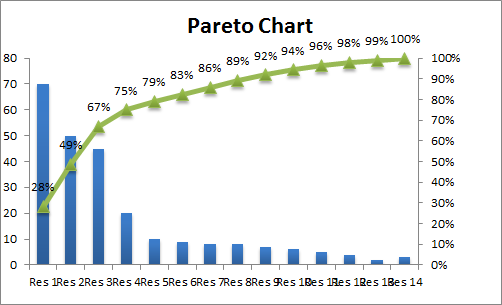

- Pareto chart in excel 2013 using data analysis how to#
- Pareto chart in excel 2013 using data analysis series#
- Pareto chart in excel 2013 using data analysis download#
In a perfect world, everything would be in harmony - every job would pay the same, every taxpayer would get the same tax benefits, every player would be equally important to a team.
Pareto chart in excel 2013 using data analysis how to#
What about you? Tell me about your experiences of using pareto analysis using comments.The tutorial explains the basics of the Pareto analysis and shows how to make a Pareto chart in different versions of Excel. I use the pareto analysis to find best way to invest my time. Jokes apart, I think pareto principle is a very powerful idea told in an extremely simple way. in most parties 80% of the beer will be consumed by 20% of people”, and the whole class started laughing. During the presentation, Anoop, my jovial team mate said, “80-20 principle can be tested anywhere. It is the topic for my first presentation too. Pareto principle is the first real management lesson I have learned during my MBA. Have you used Pareto analysis or Pareto charts in your job? Pareto charts and pareto analysis has great practical uses for almost anyone in a managerial role. To tell the story that attacking problem A might be better than solving problem C, D and F.When you want to focus your resources on few important items from a large list of possibles.During quality control to analyze the causes of defects and failures.
Pareto chart in excel 2013 using data analysis download#
Download the Pareto Chart Template in ExcelĬlick here to download the excel pareto chart template. Once you are done, the final output will be something like above chart.

We should adjust the chart formatting to make it more presentable. Finally, adjust formatting to make the final pareto chart This should ideally be pasted as a new line chart. Select the fourth column in our data table, copy and paste it in the chart.
Pareto chart in excel 2013 using data analysis series#
Select the line chart, go to “format data series” (you can also press ctrl+1) and change the axis for this chart series from “primary” to “secondary”. Move the cumulative %s line to secondary axis Learn more about combining 2 different chart types in excel combo charts. Just select it and change the series chart type to “line chart”. Excel will add another column series to the chart. Now select the chart and press ctrl+v (paste). Select the third column, press ctrl+c (copy). Add the cumulative %s to the Pareto Chart as a line In our case, we select the first 2 columns in the above table and then make a new column chart. Make a column chart using cause importance data Once you have the data ready, making the pareto chart is a simple 5 step process. You can choose any format that works for you. We will also require a dummy series to display the “cutoff %” in the Pareto chart. Once we have the values for each cause, we can easily calculate cumulative percentages using excel formulas. In order to make the pareto chart in excel, first you must have the data ready. In reality, the 80/20 principle applies to my website as well) Making a Pareto Chart in Excel (Please note that in this example, the 80/20 rule does not hold as I have chosen very small sample of data. See an example pareto chart of visits to this website: Today, we will learn how to use excel to make a pareto chart. The pareto chart is a great way to do the pareto analysis. The Pareto principle (also known as the 80-20 rule, the law of the vital few, and the principle of factor sparsity) states that, for many events, roughly 80% of the effects come from 20% of the causes. The principle behind pareto charts is called as pareto principle or more commonly the 80-20 rule. Pareto charts are often used in quality control to display most common reasons for failure, customer complaints or product defects.

A Pareto chart or pareto graph displays the importance of various factors in decreasing order in columns along with cumulative importance in a line.


 0 kommentar(er)
0 kommentar(er)
